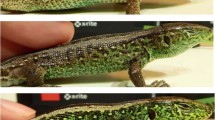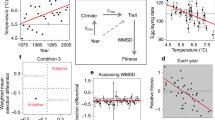Abstract
Secondary sexual traits have high heritabilities and are exposed to strong, environmentally sensitive selection, and so are expected to evolve rapidly in response to sustained environmental change. We examine the eco-evolutionary dynamics of ornament expression in a long-term study population of collared flycatchers, Ficedula albicollis, in which forehead patch size, which positively influences male reproductive success, declined markedly over 34 years. Annual fitness selection on forehead patch size switched from positive to negative during the study, a reversal that is accounted for by rising spring temperatures at the breeding site: highly ornamented males were selectively favoured following cold breeding seasons but selected against following warm breeding seasons. An ‘individual animal model’ describes a decline in the genetic values of breeding males during the study, which simulations showed was unlikely to result from drift alone. These results are thus consistent with adaptive evolution of a sexually selected trait in response to climate change.
This is a preview of subscription content, access via your institution
Access options
Access Nature and 54 other Nature Portfolio journals
Get Nature+, our best-value online-access subscription
$29.99 / 30 days
cancel any time
Subscribe to this journal
Receive 12 digital issues and online access to articles
$119.00 per year
only $9.92 per issue
Buy this article
- Purchase on Springer Link
- Instant access to full article PDF
Prices may be subject to local taxes which are calculated during checkout



Similar content being viewed by others
References
Charmantier, A. & Gienapp, P. Climate change and timing of avian breeding and migration: evolutionary versus plastic changes. Evol. Appl. 7, 15–28 (2014).
Gienapp, P., Teplitsky, C., Alho, J. S., Mills, J. A. & Merilä, J. Climate change and evolution: disentangling environmental and genetic responses. Mol. Ecol. 17, 167–178 (2008).
Merilä, J. & Hendry, A. P. Climate change, adaptation, and phenotypic plasticity: the problem and the evidence. Evol. Appl. 7, 1–14 (2014).
Gienapp, P. & Merilä, J. Disentangling plastic and genetic changes in body mass of Siberian jays. J. Evol. Biol. 27, 1849–1858 (2014).
Ozgul, A. et al. The dynamics of phenotypic change and the shrinking sheep of St. Kilda. Science 325, 464–467 (2009).
Balanyá, J., Oller, J. M., Huey, R. B., Gilchrist, G. W. & Serra, L. Global genetic change tracks global climate warming in Drosophila subobscura. Science 313, 1773–1775 (2006).
Bradshaw, W. E. & Holzapfel, C. M. Genetic shift in photoperiodic response correlated with global warming. Proc. Natl Acad. Sci. USA 98, 14509–14511 (2001).
Hill, W. G. Understanding and using quantitative genetic variation. Phil. Trans. R. Soc. B 365, 73–85 (2010).
Henderson, C. R. Best linear unbiased estimation and prediction under a selection model. Biometrics 31, 423–447 (1975).
Hadfield, J. D., Wilson, A. J., Garant, D., Sheldon, B. C. & Kruuk, L. E. B. The misuse of BLUP in ecology and evolution. Am. Nat. 175, 116–125 (2010).
van Benthem, K. J. et al. Disentangling evolutionary, plastic and demographic processes underlying trait dynamics: a review of four frameworks. Meth. Ecol. Evol. http://dx.doi.org/10.1111/2041-210x.12627 (2016).
Postma, E. Implications of the difference between true and predicted breeding values for the study of natural selection and micro-evolution. J. Evol. Biol. 19, 309–320 (2006).
Kingsolver, J. G. & Pfennig, D. W . Patterns and power of phenotypic selection in nature. BioScience 57, 561–571 (2007).
Prokuda, A. Y. & Roff, D. A. The quantitative genetics of sexually selected traits, preferred traits and preference: a review and analysis of the data. J. Evol. Biol. 27, 2283–2296 (2014).
Kusmierski, R., Borgia, G., Uy, A. & Crozier, R. H. Labile evolution of display traits in bowerbirds indicates reduced effects of phylogenetic constraint. Phil. Trans. R. Soc. Lond. B 264, 307–313 (1997).
Omland, K. E. & Lanyon, S. M. Reconstructing plumage evolution in orioles (Icterus): repeated convergence and reversal in patterns. Evolution 54, 2119–2133 (2000).
Lande, R. Models of speciation by sexual selection on polygenic traits. Proc. Natl Acad. Sci. USA 78, 3721–3725 (1981).
Zuk, M., Rotenberry, J. T. & Tinghitella, R. M. Silent night: adaptive disappearance of a sexual signal in a parasitized population of field crickets. Biol. Lett. 2, 521–524 (2006).
Pigeon, G., Festa-Bianchet, M., Coltman, D. W. & Pelletier, F. Intense selective hunting leads to artificial evolution in horn size. Evol. Appl. 9, 521–530 (2016).
Svensson, E. I. & Gosden, T. P. Contemporary evolution of secondary sexual traits in the wild. Funct. Ecol. 21, 422–433 (2007).
Wilson, A. J. & Poissant, J. in Encyclopedia of Evolutionary Biology (ed. Kliman, R. ) 361–371 (Academic Press, 2016).
Pärt, T. & Qvarnström, A. Badge size in collared flycatchers predicts outcome of male competition over territories. Anim. Behav. 54, 893–899 (1997).
Sheldon, B. C., Merilä, J., Qvarnström, A., Gustafsson, L. & Ellegren, H. Paternal genetic contribution to offspring condition predicted by size of male secondary sexual character. Phil. Trans. R. Soc Lond. B 264, 297–302 (1997).
Hegyi, G., Török, J., Tóth, L., Garamszegi, L. Z. & Rosivall, B. Rapid temporal change in the expression and age-related information content of a sexually selected trait. J. Evol. Biol. 19, 228–238 (2006).
Garant, D., Sheldon, B. C. & Gustafsson, L. Climatic and temporal effects on the expression of secondary sexual characters: genetic and environmental components. Evolution 58, 634–644 (2004).
Evans, S. R., Gustafsson, L. & Sheldon, B. C. Divergent patterns of age-dependence in ornamental and reproductive traits in the collared flycatcher. Evolution 65, 1623–1636 (2011).
Qvarnström, A., Brommer, J. E. & Gustafsson, L. Testing the genetics underlying the co-evolution of mate choice and ornament in the wild. Nature 441, 84–86 (2006).
Qvarnström, A. Experimentally increased badge size increases male competition and reduces male parental care in the collared flycatcher. Proc. R. Soc. Lond. B 264, 1225–1231 (1997).
Sætre, G.-P. et al. A sexually selected character displacement in flycatchers reinforces premating isolation. Nature 387, 589–592 (1997).
Sætre, G.-P., Post, E. & Král, M. Can environmental fluctuation prevent competitive exclusion in sympatric flycatchers? Proc. R. Soc. Lond. B 266, 1247–1251 (1999).
Ottersen, G. et al. Ecological effects of the North Atlantic Oscillation. Oecologia 128, 1–14 (2001).
Sorensen, D., Fernando, R. & Gianola, D. Inferring the trajectory of genetic variance in the course of artificial selection. Genet. Res. 77, 83–94 (2001).
Robinson, M. R., Pilkington, J. G., Clutton-Brock, T. H., Pemberton, J. M. & Kruuk, L. E. B. Environmental heterogeneity generates fluctuating selection on a secondary sexual trait. Curr. Biol. 18, 751–757 (2008).
Birkhead, T. Stormy outlook for long-term ecology studies. Nature 514, 405 (2014).
Gustafsson, L., Qvarnström, A. & Sheldon, B. C. Trade-offs between life-history traits and a secondary sexual character in male collared flycatchers. Nature 375, 311–313 (1995).
Svensson, L. Identification Guide to European Passerines 4th edn (Svensson, 1994).
Cramp, S. & Perrins, C. M. The Birds of the Western Palearctic Vol. 7 (Oxford Univ. Press, 1993).
R v.3.3.1 (R Foundation for Statistical Computing, 2016).
Pinheiro, J., Bates, D., DebRoy, S., Sarkar, D. & R Core Team nlme: Linear and Nonlinear Mixed Effects Models R package version 3.1-128 (2015); http://CRAN.R-project.org/package=nlme
Wolf, J. B. & Wade, M. J. On the assignment of fitness to parents and offspring: Whose fitness is it and when does it matter? J. Evol. Biol. 14, 347–356 (2001).
Arnold, S. J. & Wade, M. J. On the measurement of natural and sexual selection: Theory. Evolution 38, 709–719 (1984).
Sheldon, B. C. & Ellegren, H. Sexual selection resulting from extrapair paternity in collared flycatchers. Anim. Behav. 57, 285–298 (1999).
Charmantier, A. & Réale, D. How do misassigned paternities affect the estimation of heritability in the wild? Mol. Ecol. 14, 2839–2850 (2005).
Morrissey, M. B. & Wilson, A. J. Pedantics: an R package for pedigree-based genetic simulation and pedigree manipulation, characterization and viewing. Mol. Ecol. Res. 10, 711–719 (2010).
Hadfield, J. D. MCMC methods for multi-response generalized linear mixed models: the MCMCglmm R package. J. Stat. Softw. 33, 1–22 (2010).
Gianola, D. & Rosa, G. J. M. One hundred years of statistical developments in animal breeding. Annu. Rev. Anim. Biosci. 3, 19–56 (2015).
Evans, S. R. & Gustafsson, L. Data from: Climate change upends selection on ornamentation in a wild bird. Dryad Digital Repository http://doi.org/10.5061/dryad.038q1 (2017).
Acknowledgements
We are indebted to the numerous people who contributed to data collection during the study, J. Hadfield and E. McFarlane for assistance with analyses, and to T. Bonnet, E. Cole, E. Postma and B. Sheldon for discussion and advice. The long-term study was funded by a succession of grants from the Swedish Research Council; S.R.E. was funded by grants from the Swedish Research Council (to L.G.) and Zoologiska Stiftelsen.
Author information
Authors and Affiliations
Contributions
This study was conceived jointly by the authors. L.G. secured all funding for the fieldwork and was responsible for collating data. S.R.E. conducted all analyses and drafted the manuscript.
Corresponding author
Ethics declarations
Competing interests
The authors declare no competing financial interests.
Supplementary information
Supplementary information
Supplementary Figures 1 and 2, Supplementary Tables 1 and 2 (PDF 391 kb)
Rights and permissions
About this article
Cite this article
Evans, S., Gustafsson, L. Climate change upends selection on ornamentation in a wild bird. Nat Ecol Evol 1, 0039 (2017). https://doi.org/10.1038/s41559-016-0039
Received:
Accepted:
Published:
DOI: https://doi.org/10.1038/s41559-016-0039
This article is cited by
-
Heritability of climate-relevant traits in a rainforest skink
Heredity (2019)
-
Climate change ecology: Hot under the collar
Nature Ecology & Evolution (2017)



